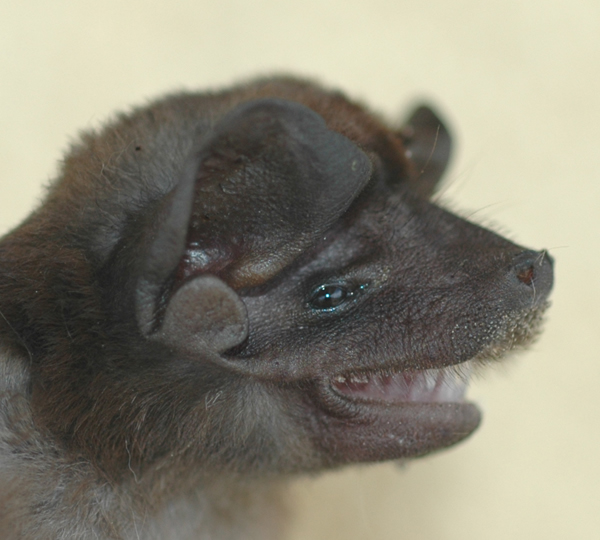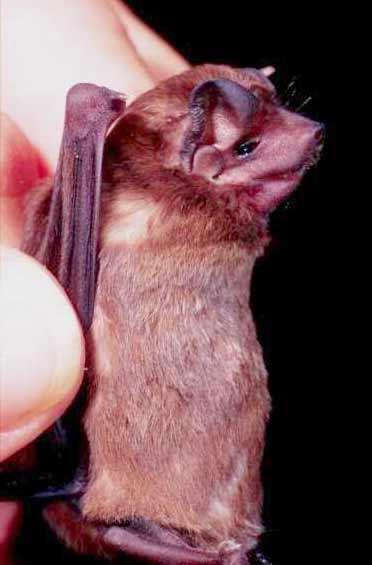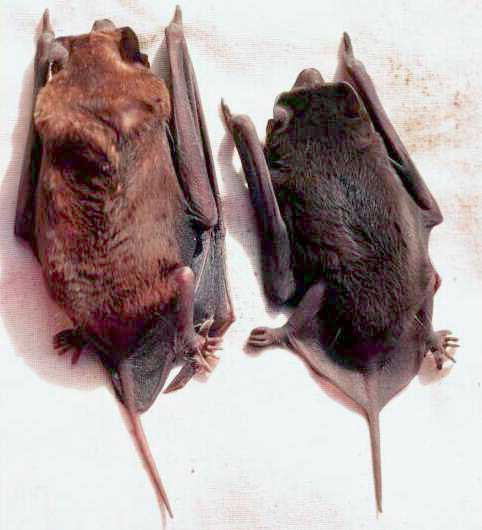Guide to the bats of Montserrat
Artibeus jamaicensis Chiroderma improvisum Brachyphylla cavernarum Noctilio leporinus Ardops nichollsi Sturnira thomasi Monophyllus plethodon Molossus molossus Tadarida brasiliensis Natalus stramineus Key to Roosts Key to Taxa
(Photo M. Morton)
(Photo M. Morton)
Velvety Free-tailed Bat - Molossus molossus
STATUS: These bats are widely distributed throughout tropical Central and South America and the islands of the Caribbean. In the Lesser Antilles they occur on every island and must be considered to be a commensal species, roosting in buidings, occupied by people or not. These bats are very common, no doubt due to the abundance of potential roosts and their insect prey. They have been captured in a wide range of habitats, but are typically are associated with buildings and ponds, rather than forests.IDENTIFICATION: These are small bats with a wingspan of just under 30mm. As in other free-tailed bats, the wings are long, thin and pointed. The tail continues beyond the trailing edge of the tail membrane, hence the name "free-tailed bat". The back legs are short and powerful making them good climbers. Their toes have interesting long hairs extending beyond the toe-nail that provide the bat a great deal of information concerning turbulence and air speed when they are pursuing insects. The rounded ears join together above the eyes giving the impression that the animal is wearing a bonnet. Unlike the Brazilian free-tailed bats that have wrinkled upper lips, the lips of Velvety free-tailed bats are smooth and unremarkable.
ROOSTS: This species is known to use a wide variety of roosts, including buildings, hollow trees and logs, caves and rock fissures and palm trees. However, it would seem to prefer crevices under the roofs of inhabited houses. Although velvety house bats are quiet during most of the day, they start scrabbling about and squeaking (often quite loudly) about an hour or so before dusk. They may also be noisy when they return to the roost during the night.DIET: Velvety house bats eat only insects; mainly moths and flying ants. They are usually the first of species of bat to emerge at dusk, often while there is still plenty of light left. They are the small, fast flying bats commonly seen just after sunset. Unlike some bats, they don't feed throughout the night, but concentrate their hunting efforts into the few hours after sunset and before sunrise. In the middle of the night they go into torpor (a hibernation-like state lasting only a few hours, in which bats let their body temperature drop to the same as their surroundings in order to conserve energy). Their droppings look very similar to those of Brazilian free-tailed bats: small (5mm x 2mm), and shaped like sausages with a smooth surface. They crumble into a fine sparkling powder because they consistmostly of insect exoskeleton.
REPRODUCTION: Velvety house bats give birth twice a year. Pregnant females have been found June-September.
SIZE: Forearm length – 38mm [range 36-41mm]; Mass – 13g [range 10-18g]; Wingspan - approx. 280mm; Head+body length - approx. 60mm.
COMMENTS: Other names Pallas’ mastiff bat. These bats eat huge numbers of (100-600 mosquito-sized) insects every night. They commonly roost in the roofs of inhabited houses and are the only bat species that seems to do this regularly. As such, they may become a nuisance because of the noise, smell, and/or droppings they leave behind.
REFERENCES:
Crepuscular activity in Molossus molossus by J. M. Chase, M. Y. Small, D. Sharma & S. Sharma in Journal of Mammalogy volume 72: pp 414-418 (1991).
See Entry: Walker's Mammals of the World Online version 5.1, by Ronald Nowak, 1997



